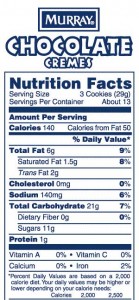Are Sugar-Free Products Better?
When taking a trip to the grocery store, you will find many products that are labeled “sugar free”. But, take caution as these products are not always an ideal choice when you have diabetes. “Sugar free” products can actually be quite deceiving. A common error that we have observed as diabetes educators is that many people read labels for the amount of sugar instead of for the amount of total carbohydrate. Even if there are zero grams of sugar in a product, the food can still have an impact on your blood sugar level. The reason for this is that it is that total carbohydrate, not only sugar, affects blood sugar levels.
Carbohydrates (Carbs) can be classified as either simple carbs or complex carbs. Simple Carbohydrates generally include foods with added sugars like regular sodas and sweets. They are called “simple” because the body does not have to perform much in the way of digestion to break them down. Simple carbs offer very little nutritional value. Complex Carbohydrates include foods that occur naturally and without processing. Foods such as fruits, starchy vegetables, whole grain breads and rice would fall into the complex category. While complex carbs will raise blood sugar levels just like simple carbs, they differ in that they contain more vitamins, minerals and fiber than simple carbs. Because of that, complex carbs are a better choice than simple carbs.
You will find sugar (simple carb) listed on the Nutrition Facts label. However, the only complex carb that you will find listed is fiber. Thus, a product may not have sugar but it can still have other carbohydrates. It is important to look at the total carbohydrate content, not only the sugar content, when you are reading a food label.
As an example, take a look at these two labels. This is a comparison of a Sugar Free and a Regular Version of cookies:
Note the difference between the two cookies: other than the nutrition label showing that the sugar-free cookie contains 0g sugar, there is very little difference. Knowing that you need to look for total carbohydrate instead of sugar makes all the difference. The total carb in the sugar free cookie is 19 grams while the total carb in the regular cookie is 21 grams. (Two grams of carb will not make a notable difference in your blood sugar level.) One carb serving/exchange is equivalent to 15 grams of carbohydrate. Although carbohydrate needs are very individualized, most people with diabetes will need to keep their mealtime carbs between 30 to 60 grams (2 to 4 servings/exchanges) and their snacks between 15 to 30 grams (1 to 2 servings/exchanges). Registered Dietitians who are Certified Diabetes Educators, such as John and I at nutritionpair.com, can assist you in determining your individual carbohydrate needs.
Back to the cookies—I should note the price per cookie. The sugar-free cookies cost 15 cents per cookie and the regular cookies cost 4 cents per cookie. The sugar-free cookies cost almost four times as much as the regular cookie! As you can see from the comparison above, there is very little difference in the impact the two different products would have on your blood sugar level. Your blood sugar reading would likely be the same after the sugar-free cookies as it would after the regular cookies. As you can see, you really don’t need to spend the extra money on “diabetic” or “sugar-free” products when you have diabetes. Just be a label reader and look at the total carbohydrate instead of the sugar. While you’re at it, check to make sure the product is low in saturated fat, high in fiber and high in vitamins and minerals. But, remember, the healthiest foods do not even have a nutrition label on them (hint: they are in the produce section!!!).
~ Angie

